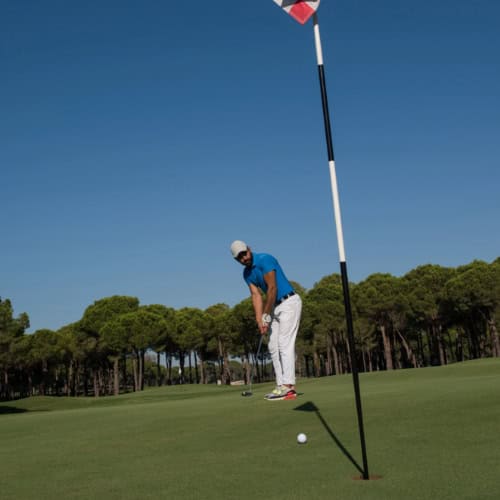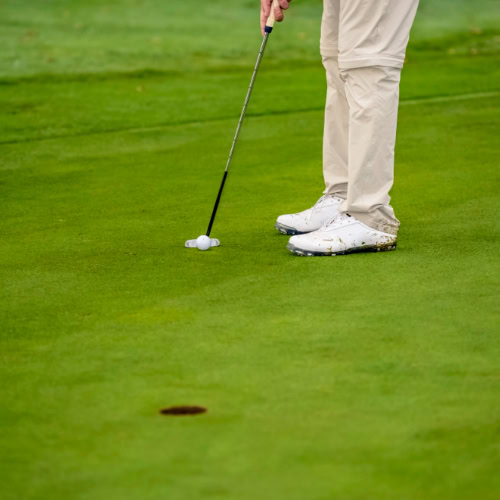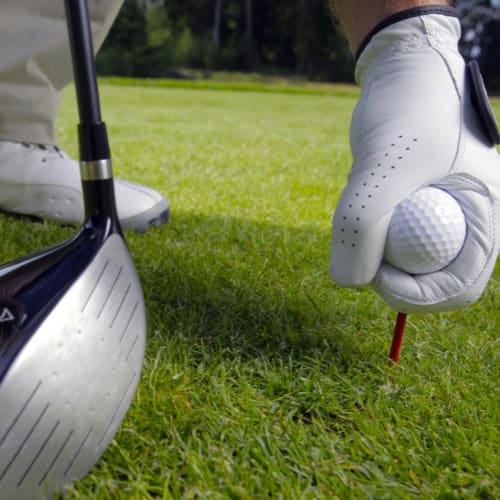You’re leaking 4–6 shots a round, not from your swing, but from choices. Simple decision trees fix that. Think center-of-green targets, safe-side tee lines, smart lay-up math, and clear green-light/red-light calls—clean and quick, like a checklist you can trust. Call it your card: a tiny prompt that keeps you out of water, bunkers and three-putt land.
You’ll get fast rules you can use today, miss planning that dodges doubles, yardage windows that suit your wedges, and pace-friendly routines that keep play moving. No jargon. No overhaul. Just practical course management for mid handicaps that travels from the range to the first tee without drama.
- 1) Quick-Start Decision Tree: Save 4–6 Strokes Today
- 2) Targeting Rules That Lower Scores (Without New Mechanics)
- 3) Miss Planning & Bailouts: Turn Doubles Into Pars/Bogeys
- 4) Lay-Up Math & Yardage Mapping for Mid Caps
- 5) Green-Light / Yellow-Light / Red-Light Rules
- 6) Around-the-Green & Putting: Simple, Repeatable Choices
- 7) Tee-Box Strategy Using Dispersion & Tendencies
- 8) On-Course Routine & Fast Decisions (Pace-Friendly)
-
9)
Frequently Asked Questions
- 9.1) How do I build a pocket-size decision card from my stats in 30 minutes?
- 9.2) What’s the fastest way to measure my driver dispersion at the range without a launch monitor?
- 9.3) How can I find my personal “money” lay-up yardage in one practice session?
- 9.4) What pre-round course scout should I do if I’ve never played the track before?
- 9.5) Should my targets or aggressiveness change in match play versus stroke play?
- 9.6) How do I decide whether to adopt a fade or a draw as my long-term stock shot for strategy?
- 9.7) Which three stats should I track to prove I’m actually saving 4–6 strokes from course management?
- 10) Final Thoughts
Quick-Start Decision Tree: Save 4–6 Strokes Today
The wrong choice can cost you two shots before you blink. The right one keeps you in play and trims strokes from your card.
First, flags surrounded by bunkers or water are bait. Don’t bite. Aim for the middle of the green. Tiger and Jack made careers out of hitting safe centers, not hunting every stick.

Next, picture a fairway with trouble left. Trees, water, maybe out-of-bounds. Forget flirting with that line. Shift your aim to the right, even if it means the rough. A bogey beats a penalty stroke every time.
Now, let the wind talk. Into a breeze or uphill, don’t swing harder. Club up. A smooth, longer club will hold its line better than a forced swing that balloons and stalls.
Bad lie? Blind landing area? Resist the hero shot. Lay up to a comfortable wedge yardage, something in the 80 to 110 range that you trust. From there, your odds of hitting the green skyrocket.
If stuck in trouble under branches, don’t carve miracle curves. Grab your longest iron with little loft, punch it out and give yourself a clean look. Par might still be in play, but double is off the table.
When standing between clubs, pick the longer one. A smooth swing that carries trouble in front is better than a short miss in the sand.
Finally, when the fairway narrows at your driver distance, stop pulling driver just because it feels right. Play a three-shot plan: wood or iron off the tee, another position shot, then wedge in. It’s boring golf, and boring golf posts low numbers.
Targeting Rules That Lower Scores (Without New Mechanics)

Better scores come from smarter targets, not riskier swings. These rules show you where to aim so you avoid trouble and play to your strengths.
Middle-Over-Flag Targeting
The flag tempts you like a flame tempts a moth. When it’s tucked behind a bunker or water, resist. Aim for the middle of the green. A 30-foot putt is painless compared to a splash or a buried lie. Even Tiger and Jack lived by that play: center first, birdie second.
Safe-Side Aiming Off the Tee
On the tee, your goal isn’t glory. It’s keeping the ball alive. If there’s trouble left, shift your line well right. Even the rough is a win compared to trees or out-of-bounds. Safe side aiming keeps doubles off your card, and doubles are what inflate handicaps.
Match Shot Shape to the Hole
Every hole has a shape. Yours does too. If you draw the ball naturally, pick a line that lets it work back into the fairway. If you fade, do the opposite. Don’t fight your pattern to please the layout. Trust your built-in shape; it’s your compass.
Verify Yardage, Don’t Trust Optics
Eyes lie. Elevated greens look closer, downhill holes look shorter. Always double-check the number before you swing. Use your rangefinder or a marker, not your gut.
Targets that trick you visually are waiting to snare careless players. If you want fewer big numbers, trust the data, not the view.
Miss Planning & Bailouts: Turn Doubles Into Pars/Bogeys

Bad swings happen, but poor decisions make them worse. By planning where you can safely miss and how to escape trouble, you turn disasters into recoveries and doubles into bogeys.
Define Your “Okay Miss”
Every swing has a pattern. You tend to miss left or right more often than not. Own it. If you usually leak shots right, aim to the left edge of the green or fairway.
That way your normal miss still leaves you safe. The fat side is your friend, as short putts beat penalty drops.
The Punch-Out Protocol
Trouble comes fast. A tree limb, a bare lie, a tight gap. The hero shot whispers in your ear. Don’t listen. Instead, pull a long iron with little loft, play the ball back and drive it down with a short finish. Keep it low, keep it straight, keep it simple.
You don’t need distance, just a good angle for your next swing.
Acceptable Outcomes Mindset
Pressure builds when you think every hole must be a par. That’s not how mid-handicap golf works. If you’re into the wind on a long par-4, a bogey is a win. Facing water and bunkers everywhere? Aim to miss where recovery is possible. You trade one stroke now to save two later.
When recovery means escaping sand, beginners often struggle with technique and confidence. Learning how to hit out of the bunker can turn a likely double into a safe bogey or even a par save, making it an essential skill for mid-handicap golfers.
Lay-Up Math & Yardage Mapping for Mid Caps

Laying up sounds boring, but it wins rounds. The trick is to use math, not guesswork. When you plan yardages and map hazards, you avoid the roulette wheel of half-wedges and blind swings.
Hazard Mapping Before You Swing
Before every shot, picture the course as numbers. How far to clear water? Where does the bunker start? What distance brings the trees into play?
Write these down in a yardage book or keep them in your head. Hazards shrink when you know their exact limits.
Choose the Right Lay-Up Window
You want a number that gives you confidence. For most mid handicaps, that’s a full wedge, something between 80 and 110 yards. Avoid leaving yourself a 40-yard half swing. Those awkward shots bleed strokes because they lack spin and consistency. Play to the yardage you own.
Par-5 and Drivable Par-4 Decision Trees
On a par-5, if the fairway pinches at 260 and your driver runs hot, don’t flirt with it. Lay back with an iron and leave a clear second. Then pick a lay-up that lands you at your best wedge yardage.
On a short par-4 with water hugging the green, the safe card is a 190–200 shot that leaves you around 100 yards. You’ll still have birdie chances, but without the risk of splashing driver.
Green-Light / Yellow-Light / Red-Light Rules

Not every shot deserves the green light. Some need caution, and others scream stop. If you learn to color-code your decisions, you’ll stop handing away strokes.
Variables: Lie, Wind, Firmness, Pin, Dispersion, Confidence
A flat fairway with room long and short? That’s green. Go ahead and swing.
Crosswind and a tucked pin? That’s yellow. Aim safe, take the spin off and commit to a controlled shot.
A downhill lie with water short and bunkers tight? That’s red. Lay up, punch out or take your medicine. A bogey beats disaster.
Your dispersion pattern matters here. If your driver misses 25 yards both ways, don’t force it into a 20-yard fairway. Know your boundaries, then let those numbers decide the light.
Worked Examples
Picture an uphill par-3 into a stiff breeze. Green says “club up” and swing smooth. Yellow warns you not to muscle it. Trust the longer club.
Now think about 178 yards with a bunker wall in front. You’re between 7 and 8. Yellow suggests the 7, with a shorter swing that runs onto the green. It clears the trouble, even if it finishes long.
Around-the-Green & Putting: Simple, Repeatable Choices

When the ball is close to the green, your margin for error shrinks. A smart, simple approach turns three shots into two more often than not.
Chip-and-Run Defaults
Your safest tool is the chip-and-run. Set the heel up, toe down, stand a little closer, and quiet the wrists. Land the ball just onto the green and let it roll.
If the lie is fluffy or you’re uphill into the wind, stand the shaft more upright and feel a gentle draw release. Simple tweaks keep the shot predictable.
Partial-Wedge Setup Tweaks
Partial wedges can wreck a round if the face closes. Counter that by raising the handle slightly, which makes the club sit more upright and reduces flip.
Keep the leading edge flush to the ground. From there, you’ll strike it cleaner and avoid sharp pulls.
Pace-First Putting
Speed matters more than line on most putts. Downhill or fast greens demand touch. A putt rolling too hot will miss no matter how perfect the read.
Remember, the ball leaves the fringe quicker than it looks, so expect early roll-out. On the practice green, don’t waste time on 20-foot make drills. Spend it grooving speed control, nailing short putts and starting the ball online.
Tee-Box Strategy Using Dispersion & Tendencies

Every round starts on the tee. How you manage that first swing often decides whether the hole is smooth or messy. A clear plan matched to your tendencies keeps the ball in play and your scorecard intact.
Pick the Club That Fits the Window
Your driver feels powerful, but it’s not always the answer. If the fairway is tight and hazards lurk inside your dispersion window, step down.
A 3-wood or long iron to the widest part of the corridor beats reloading after a penalty. Think corridor first, club second.
Choose and Keep a Stock Shape
Don’t fight your DNA. If your natural ball flight is a fade, use it. Same for a draw. Set your line to fit the hole, then let your shape work back into play.
Trying to curve it the other way mid-round usually ends in trouble. A stock shot builds trust, and trust builds consistency.
Small Mental Edges
Tiny habits save strokes. Don’t carry an extra ball in your pocket, or you’ll subconsciously expect a miss. Step onto the tee with one ball, one plan, one swing. Commit fully.
On-Course Routine & Fast Decisions (Pace-Friendly)

Speed of play matters, but not at the cost of sloppy choices. A steady, repeatable routine helps you pick the right shot without grinding the group behind you.
- Assess: Look at lie, wind, trouble, firmness, and pin position. You need only ten seconds to spot the key factors.
- Decide: Use a quick color call—green, yellow or red—to lock in target and club. That single choice clears your head.
- Plan the miss: Identify where the safe bailout is and the yardage you’ll want next. Even if the shot goes wrong, you’re covered.
- Rehearse once: Feel the move you want, maybe just the first foot of takeaway. No need for practice swings on repeat.
- Commit and swing: Step up, aim and pull the trigger with conviction.
Frequently Asked Questions
Every golfer wrestles with strategy questions on the course. Our team provided answers to give you quick, practical solutions you can use right away.
How do I build a pocket-size decision card from my stats in 30 minutes?
Start with your last 5–10 rounds. Note where you miss most often: left/right off the tee, short/long on approaches. Add your go-to lay-up yardage and preferred miss side. Write three bullet reminders: safe-side aim, favorite wedge number and punch-out protocol. Fit it on a 3×5 card and keep it in your scorecard holder.
What’s the fastest way to measure my driver dispersion at the range without a launch monitor?
Pick a target line, then hit 10 balls with your driver. Place tees or range markers at the widest two balls left and right. That’s your dispersion window. Repeat with your 3-wood or long iron for comparison. You’ll quickly see which club clears more fairway safely.
How can I find my personal “money” lay-up yardage in one practice session?
On the range, hit 10 balls each from 60, 80, 100, and 120 yards. Track which distance gives you the most solid contact and tightest grouping. That’s your wedge comfort zone. On the course, lay up to that number whenever you can.
What pre-round course scout should I do if I’ve never played the track before?
Check the scorecard for par-5 lengths and par-3 hazards. Use Google Maps or the course app to preview tight fairways or water carries. Note any “must-lay-up” holes. Walking to the first tee, remind yourself: smart targets beat blind aggression.
Should my targets or aggressiveness change in match play versus stroke play?
Yes. In match play, a double bogey hurts less (only one hole lost), so you can take a calculated risk if your opponent is in trouble. In stroke play, every stroke counts, so stick to safe-side aims and controlled misses.
How do I decide whether to adopt a fade or a draw as my long-term stock shot for strategy?
Look at your natural tendency. If you miss right more often, a fade gives you control. If you miss left, a draw may settle you down. Pick one you can reproduce under pressure and build your tee-box strategy around it.
Which three stats should I track to prove I’m actually saving 4–6 strokes from course management?
Here they are:
– Penalty strokes per round (water, OB, trees).
– Up-and-down percentage inside 30 yards.
– Greens hit in regulation from smart targets.
If those improve while your swing stays the same, the math doesn’t lie—you’re managing the course better.
Final Thoughts
Course management isn’t about playing safe golf—it’s about playing smart golf. By aiming for the center when flags hide behind trouble, favoring the safe side off the tee, and mapping lay-ups to yardages you trust, you give yourself room to breathe.
You don’t need new mechanics to save strokes. A few decision trees are enough to turn doubles into bogeys and bogeys into pars.
Around the greens, one stock chip and one partial wedge setup do more for your scorecard than a dozen fancy shots you’ll never practice. On the putting surface, pace control rules all.
The real key is consistency. Build a routine, stick to it and let your strategy guide you when nerves try to take over. The strokes you save may not come in fireworks, but they’ll add up quietly.
And when you sign your card and see four to six fewer shots than usual, you’ll realize the secret wasn’t a new swing at all; it was learning how to think your way around the course.
If you want a structured way to sharpen your short game alongside these decision trees, try this 30-minute wedge & putting practice that builds consistency under time pressure. It complements smart course management by giving you reliable shots inside 100 yards.





